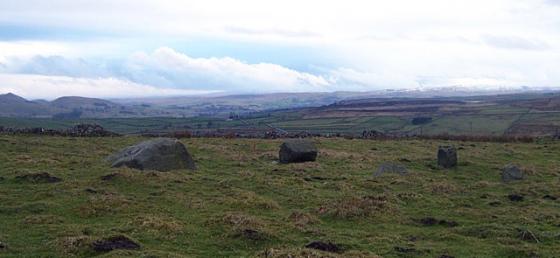
The carved stone two-and-a-half years since it was vandalised. Thankfully, the red paint appears to be weathering off. The word ‘RED’ looked like a fairly recent addition, scratched onto the surface.

The carved stone two-and-a-half years since it was vandalised. Thankfully, the red paint appears to be weathering off. The word ‘RED’ looked like a fairly recent addition, scratched onto the surface.

15-10-05
.o0O0o.

15/10/05

15/10/05
Red paint....such a bloody shame...
anyone who chalks or paints in carvings needs there head examined.

To illustrate the appauling damage that has been done to this great stone.

Willy Hall’s Wood Stone

A cluster of rocks just north of the main stone bear cup marks.

‘Entrance’ stone to Willy Hall’s Wood, with what are probably natural cups. None the less, I feel strongly that this stone had a significance in its position.



April 2004 and the paint is still there.

Willy Halls Wood from the bottom of White Wells. Streams flow around both sides of the mound which is topped by the Willy Halls Wood Stone. Both join to merge at Willy Halls Spout at the bottom of the mound, then flow on down to the river Wharfe. A very powerful spot indeed.

08/03. Nice one!

View of the southern end of Willy Hall’s Wood with the stone in the centre of the picture.




An easy route is to approach from the east over Ilkley Crags and past the Pepperpot Rock, this brings you to the back of Willy Hall’s Wood.
This is one of my favourite spots to while away time on these moors. The atmosphere is buzzing and it’s not hard to see why this would have been a sacred spot in prehistoric times... in fact, it still is now. Willy Hall’s Wood is a mound surrounded by two streams which drain off of Green Gates and join again at the bottom of the mound at Willy Hall’s Spout. The stream then flows down into Ilkley under Brooke Street and joins the Wharfe at the bridge near the Roman Fort of Olicana.
Near the crossing of the eastern stream is an upright boulder with a number of large bowls or cups on it’s eastern face. I’m uncertain whether they were fashioned or are natural (I have seen many similar features on a number of rocks around Ilkley Moor), but I am certain that it’s not there by accident and feels very much like an ‘entrance’ to the site. A few yards north of the main rock is a cluster of small boulders, one of which has a small cup on it’s top.
Unfortunately, Willy Hall’s Wood Stone still bears the marks of someone’s utter stupidity. As previously shown here, someone has followed the design in red paint and added runic nonsense to the north facing side of the stone. The paint seems to be an acrylic and has dried to a rock hard, matt finish which will take decades to weather away naturally. A curse on the backward thinking motherf*cker.
Still, even this vandalism can’t detract from the beauty and sacred intent of this spot.
13 April 2004 and the paint is still there. No sign of it naturally weathering off. It will require a professional job to remove it.
Pity because today was a beautiful day with the shadows of the trees playing on the rock. An atmosphere spoilt by this act of vandalism.
Photos converted to B/W take away some of the horror, but not much.
258 in “Prehistoric Rock Art of the West Riding”
SE 11587 46582
Just got back from my first trip to Ilkley in a few months and what can I say that Stubob hasn’t already, what an absolute disgrace. This is one of the most perfectly situated, unpublicised sites on the moor and it’s now been damaged, quite possibly forever, by a mindless, selfish idiot. Shame on you whoever did this.
Great looking stone.....
Now totally f***ed up by an arse with a can of red paint.
This site is fairly straightforward to get to, although not necessarily easy. There is plenty of parking space at White Wells carpark – walk to the old pump house and then head due south uphill keeping the white building of the old bathhouse to your left and head towards the waterfall. Once you get there is a very steep climb up beside the small falls (there may well be easier routes round the side) that leads to the outcrop of land the forms the north end of Willy Hall’s Wood. This is the place that Gyrus mentions on the main Rombald’s Moor page – it is indeed a wonderful place and has an air of ‘sacred grove’ about it. Continue south through the trees and just before they end you will find the large tilted stone with carvings across its southern face, these consist of about 17 cups, some of which have rings and some with interconnecting grooves. Just beyond the carved rock is another boulder that has three large saucer shaped indentations – I thought they may have been man-made but found out later from a knowledgeable local that he believed they were natural.
When I looked at my photo’s, the sunlight had caused the carvings to be almost invisible, but I noticed that the trees, stone and landscape seemed to be at chaotic angles – it wasn’t just my poor photography, this place is really like that.



































































































































